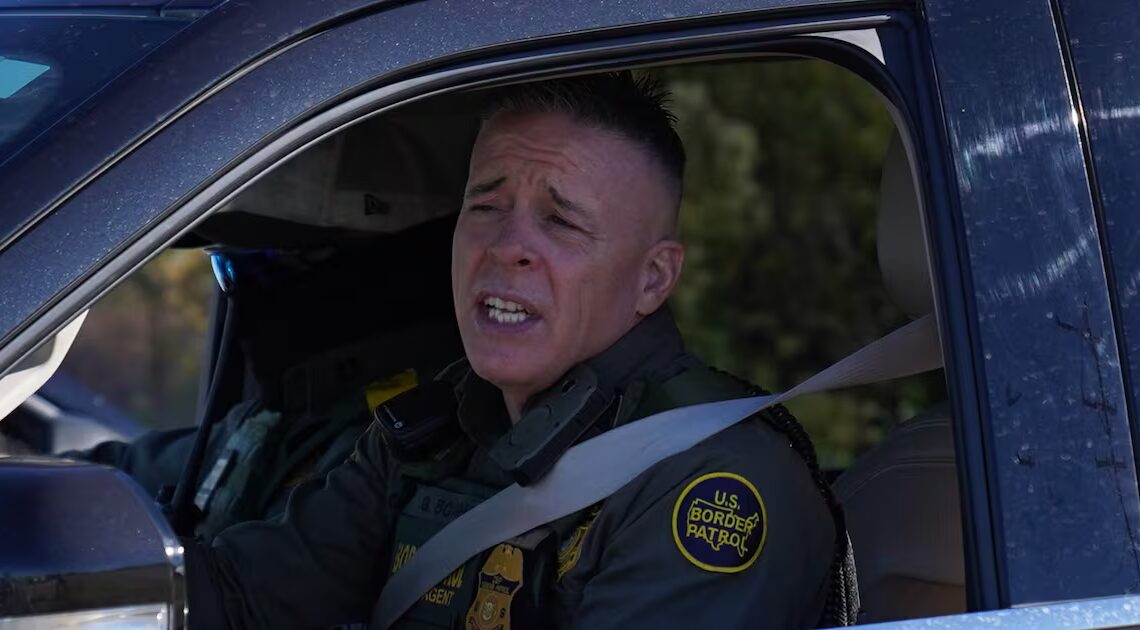Border Patrol agents armed with hidden cameras and AI-driven algorithms are flagging millions of American drivers as “suspicious” and triggering covert traffic stops across the country, according to a new investigation.
The Trump administration has quietly expanded a vast domestic surveillance web that tracks and analyzes the travel patterns of millions of drivers—feeding local police tips that lead to secretive traffic stops, searches, and arrests, the Associated Press reports.
The intelligence project, built and run by Border Patrol’s parent agency, U.S. Customs and Border Protection (CBP) gathers vehicle movements through a national network of covert license plate readers disguised inside roadside barrels, cones, and job-site equipment, AP reports.

Images are run through an algorithm that flags “abnormal” routes, quick turnarounds, or travel linked to border regions. Local officers are then prompted to pull drivers over—without revealing the real reason they were targeted.
Many stops cite minor infractions, such as going a few miles over the speed limit, a window-tint issue, or even a dangling air freshener, according to police reports reviewed by AP. But drivers are then interrogated about their movements and belongings, sometimes for more than an hour, with no idea they were first flagged miles away by a Border Patrol analyst monitoring a screen.
The surveillance has sprawled deep into U.S. cities. The outlet identified camera placements more than 120 miles from the Mexican border in the Phoenix area, and others near Detroit and the Michigan-Indiana line—far outside the agency’s typical jurisdiction of 100 miles from a border.
CBP, which falls under the Department of Homeland Security, told AP it is legally allowed “to operate anywhere in the United States.”

One targeted motorist, 45-year-old Texas driver Lorenzo Gutierrez Lugo, was stopped in Kingsville, Texas, after Border Patrol requested police pull over his black Dodge pickup, which was towing a white trailer. Officers searched the vehicle and found only customer cash for his delivery job. He was arrested anyway on suspicion of money laundering, but the case was ultimately dropped. His employer told AP he spent $20,000 clearing his name.
In another case, Houston resident Alek Schott, 37, was flagged after an overnight trip to Carrizo Springs for work. Deputies held him by the side of the road for more than an hour and tore through his car. Nothing illegal was found. Deputies later testified that federal agents “watch travel patterns on the highway” via license-plate scans and other surveillance tools—and that the Texas Traffic Code offers “thousands of things you can stop a vehicle for.”
Recovered WhatsApp group chats between Border Patrol and Texas deputies—labeled “Northwest Highway”—show officers swapping intelligence on rental cars, rideshare drivers, social-media profiles, and home addresses. Messages were frequently set to auto-delete.

Legal scholars warn that the scale of the data collection—tracking “patterns of life” for millions of ordinary drivers—could violate the Fourth Amendment. “Large-scale surveillance technology that’s capturing everyone and everywhere at every time” may be unconstitutional, Andrew Ferguson, a law professor at George Washington University, told AP.
The program is powered by an enormous expansion of CBP’s intelligence capabilities since President Donald Trump returned to office. Congress has authorized more than $2.7 billion to layer artificial intelligence onto existing surveillance networks.
Meanwhile, Operation Stonegarden—a two-decade-old federal grant scheme—now channels hundreds of millions of dollars to local sheriff’s offices to buy license-plate readers and drones, and to fund overtime that effectively deputizes local cops into Border Patrol’s mission. Under Trump, congressional Republicans increased Stonegarden to $450 million over four fiscal years.

In Cochise County, Arizona, Sheriff Mark Dannels said Stonegarden allows his deputies to “merge their mission with Border Patrol’s.” AP found documents showing Border Patrol can plug locally owned plate readers—funded with Stonegarden money—directly into its intelligence systems, vastly multiplying the dragnet.
Even some former Border Patrol officials admit the tech is a supersized version of the hunch-based tactics agents once used on desert roads—only now automated, data-driven, and nationwide. “They have a lot of toys over there on the federal side,” one Texas deputy said in a deposition.
CBP insists its systems are governed by “federal law and constitutional protections” but refused to describe its operational use. In multiple states, the agency instructed officials to withhold surveillance records from public requesters, according to emails obtained by AP.
Schott, who was stuck by the side of the road as Border Patrol searched through his car, said the experience revealed a troubling reality: “For every one person like me… there’s 1,000 people who just leave frustrated and angry.” He added: “I didn’t know it was illegal to drive in Texas.”
The Daily Beast has contacted DHS for comment.
AP reviewed thousands of pages of court records, grants, and internal documents, and interviewed former government officials with direct knowledge of the program.
The post Trump Hatches Creepy New Plot to Target ‘Suspicious’ Drivers appeared first on The Daily Beast.




